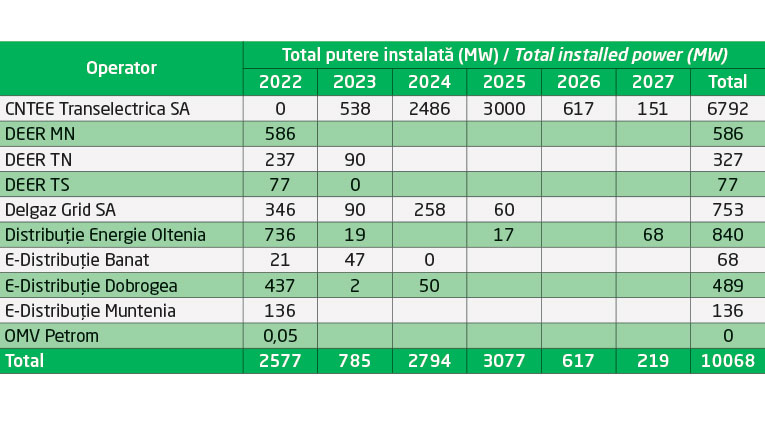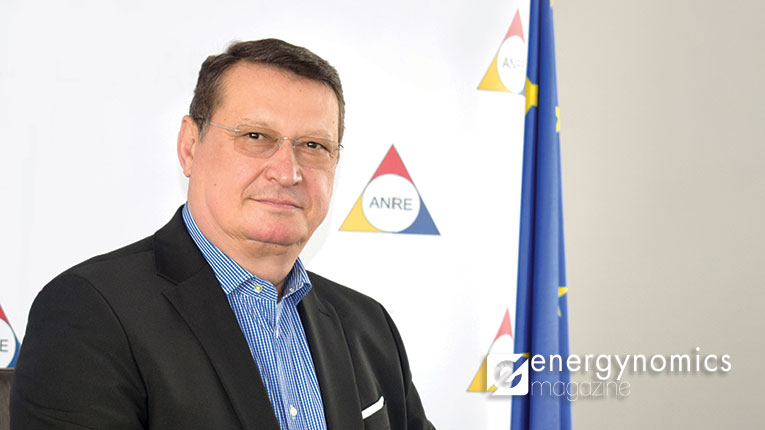In 2022, ANRE granted 11 new authorizations for the establishment of large renewable projects, with a total power of 695.9 MW. At the same time, in the next period, with a high degree of certainty regarding the realization and commissioning, I estimate an increase of 965.97 MW in the total power installed in new plants, Dumitru Chiriță, the president of the National Energy Regulatory Authority, tells Energynomics. ANRE has taken measures to remove market access barriers, also by allowing bilateral contracts and creating flexible market instruments. Facilities have also been created regarding the connection to the grid, especially for prosumers, correlated with the facilities granted by law for the utilization of the surplus energy produced. “Regarding the perspective of the evolution of the connection of new prosumers in 2023, a cautious estimate indicates the possibility that another 25,000-30,000 prosumers will be added in the following year to the approximately 30,000 prosumers which will be registered by the end of the current year,” added the president of ANRE.
What are the latest trends, figures and statistics related to the connection requests of large wind and solar projects recently? What about storage (percentage and volume)? What are the top 10 projects?
In relation to the trends regarding the connection of prosumers, the connection requests in the records of CN Transelectrica SA and the distribution operators are of the order of tens of thousands, being relevant only in terms of the interest shown by the economic operators. The completion of actual connections of new capacities is far below 10% of the number of applications submitted.
 I present below a situation of the connection contracts on file with the network operators, the powers that are intended to be connected and the commissioning estimate on 30.09.2022.
I present below a situation of the connection contracts on file with the network operators, the powers that are intended to be connected and the commissioning estimate on 30.09.2022.
With regard to projects with large installed capacities, in the order of tens of MW, the National Energy Regulatory Authority granted in 2022 a number of 11 new establishment authorizations with a total capacity of 695.9 MW. At the same time, in the next period, with a high degree of certainty regarding the realization and commissioning, I estimate an increase of 965.97 MW in the total power installed in new plants.
In terms of storage, investments are slow, so at the moment we have granted two establishment authorizations for:
- CET ARAD SA for 2×1 MW storage facility and heat engine battery with Pe of 21.84 MW and Pt 21 MW (already put into operation and included in the License)
- MEGALODON STORAGE SRL for a 7.4 MW Pe storage facility that is not added to an electricity production capacity (they are already in operation and a License is to be granted).
What are the key figures and statistics related to prosumer connection requests? What about storage?
The situation regarding number of prosumers connected to the distribution network of concessionary distribution operators at the end of September is of 26,877 prosumers, and their total installed power is of 256,141 KW.
Regarding the perspective of the evolution of the connection of new prosumers in 2023, a cautious estimate indicates the possibility that another 25,000-30,000 prosumers will be added next year to the approximately 30,000 prosumers which will be registered by the end of the current year. Obviously, this number is dependent on the existence of stocks of photovoltaic panels, inverters and measurement and protection equipment in the specific market for the following year, and not least on the existence of qualified personnel to carry out the installations and submit the specific documentation to the network operators.
What were the main actions of ANRE recently taken to facilitate the acceleration of investments in renewables and to ensure our energy independence?
ANRE has taken measures to remove market access barriers, including by allowing bilateral contracts and creating flexible market instruments. Facilities have also been created regarding the connection to the networks, especially for prosumers, correlated with the facilities granted by law for the utilization of the surplus energy produced.
From the point of view of the process of connecting to the public interest electric networks of the installations producing electricity from renewable sources, we revised the regulatory framework regarding the connection of users to the public interest electric networks.
Regarding the connection to the electricity grids of the places of consumption and production belonging to the prosumers, we have developed a procedure dedicated to this category of users, with the description of the connection process both for new places of consumption and production, as well as for the situation of the installation of capacities of production from renewable sources at existing places of consumption. The procedure is addressed to prosumers that own electricity production facilities from renewable sources with installed powers of up to 400 kW.
As part of the connection process, for the activities of the distribution operator, we have allocated reduced deadlines compared to those for other categories of users and established provisions whereby the respective users have the opportunity to choose and even conclude the contract with a certified economic operator for the design and execution of the connection installation.
Likewise, in the event that installations for the production of electricity from renewable sources are connected to the installation for the use of an existing place of consumption and no additional work or changes are carried out in the existing electrical installations upstream of the point of demarcation with the public electricity network, the distribution operator issues the connection certificate without needing to update the technical connection approval, based on a notification from the user. The notification, accompanied by the complete documentation provided for in it, is sent after the construction of the electricity production facility connected to the existing place of consumption.
For each of the possible situations regarding the connection of prosumers, the procedure provides framework formats for the connection request, with the explicit mention of the necessary information regarding the user, the technical data related to the installation of use and the necessary documents.
All this contributes to reducing the duration of the entire process, thus facilitating the connection of as many prosumers as possible. In support of the prosumers are also the provisions of the regulatory framework regarding the bearing by the distribution operator of the costs of the purchase and installation of the electricity measurement group or the fully equipped measurement and protection block. At the same time, the distribution operator has the obligation to make these equipment available to the certified economic operator who executes the connection installation, with the exception of the electricity measuring meter, and the certified economic operator is responsible for installing them.
Considering the difficulties encountered by distribution operators in the recent period regarding the supply of meters for electricity measurement, in order to avoid blocking the process of connecting the prosumers, derogatory provisions from the condition of connecting of the installations were included in the procedure use for the installation of the necessary measurement groups in the prosumer installations.
Also, in order to provide as much information as possible regarding the process of connecting the places of consumption and production belonging to prosumers, we have drawn up a guide dedicated to this category of users and created schemes that describe the stages of the connection process for all the situations provided for in the procedure, detailing the activities assigned to the user, the distribution operator and the certified economic operator who designs and executes the connection installation, as well as mentioning the terms related to each activity, provided for in the normative act.
What should we do to have a market better fit for renewables? Or to accelerate network investments? How about demand-response – what can be done to accelerate its adoption in Romania?
In order to have a market better adapted to renewables, first of all, a stable, predictable, competitive business environment is needed, which confers sustainability on investments. Overcoming crisis situations is mandatory, but part of the crisis is even the lack of energy from alternative sources to the classic ones. Renewables are option no. 1 in this context and investments in the grid are inevitable. However, adaptation/optimization of small/micro local production to consumption in the immediate vicinity can substitute network investments by offloading them upstream.
Also, in order to ensure the proper functioning of renewables, without making further changes to the energy market, strong incentives for storage should be introduced first, which would also solve the increase in the absorption capacity of the grids for new renewable capacities, without any additional investments.
Regarding the Demand-response solution, it is an option that is very price-dependent. On the current trend of reducing consumption as a result of the accelerated increase in market prices, the implementation of such an option must be carefully weighed from the point of view of economic efficiency and budgetary effort. Demand-response has created the regulatory framework for capitalization in the market (including as a balancing resource), but so far has not generated interest from end-customers. The specter of possible disconnections or limitations in the event of an energy crisis or energy emergency could in the future cause end-customers to reconsider the option of capitalizing on their response capabilities.
_____________________________________________
This interview first appeared in the printed edition of Energynomics Magazine, issued in December 2022.
In order to receive the printed or electronic issue of Energynomics Magazine, we encourage you to write us at office [at] energynomics.ro to include you in our distribution list. All previous editions are available HERE.

